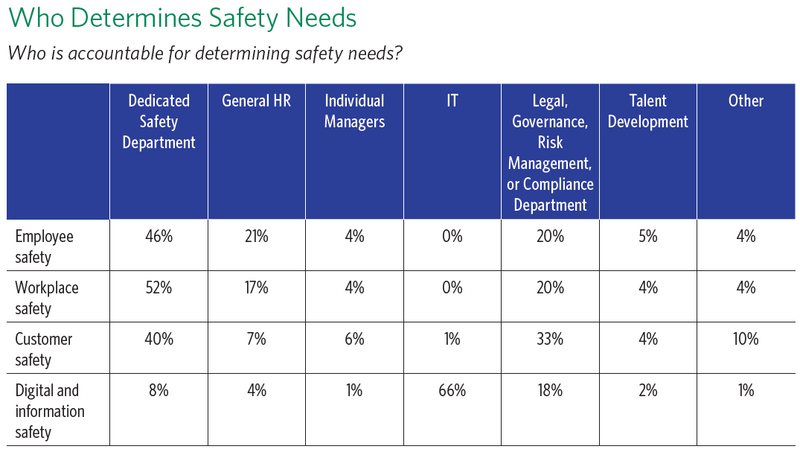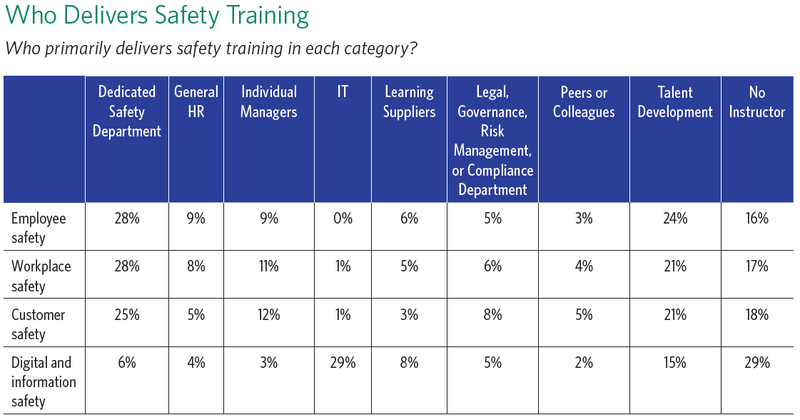ATD Blog
Who Makes the Call on Safety Training?
Wed May 06 2020

The Bureau of Labor Statistics estimates that the United States experienced 5,250 fatal workplace injuries in 2018. The year prior, preventable work injuries cost the U.S. economy $161.5 billion, according to an estimate from the National Safety Council. These statistics make clear the importance of safety for organizations and, therefore, safety training. The top benefit of safety training, according to the new ATD research report Safety Training: Protecting Employees and Organizations is reducing these tragic and costly incidents.
One essential question for any safety training program is who should do what. Who should be accountable for determining an organization’s safety needs? What about developing safety content or choosing supplier content? What about delivering safety training? Should the answers to these questions change for training that deals with different types of training?
Definitions
For Safety Training: Protecting Employees and Organizations, ATD Research identified four types of safety and asked organizations about their practices for each category, including:
employee safety: related to the performance of jobs and use of facilities and equipment
workplace safety: related to emergencies in the workplace such as disasters or crime
customer safety: related to the physical safety of customers
digital and information safety: related to employee or customer data and cybersecurity.
Determining Safety Needs
Organizations were most likely to hold a dedicated safety department accountable for determining safety needs for all categories of safety other than digital and information safety (Table: Who Determines Safety Needs). They were most likely to entrust their IT departments with determining safety needs for digital and information safety. Legal, governance, risk management, or compliance departments were second-most likely to be accountable for determining safety needs for all categories of safety other than employee safety. HR departments were most likely to do so for employee safety.

According to Errick Currie, a logistics transportation for Domino’s who oversees safety for truck drivers that deliver supplies to the company’s stores in the United States and Canada, which department makes the final call on determining needs is of limited consequence. In an interview for the report, he said that “ensuring that every employee has a voice” about safety matters much more. “Every organization is different,” he explained, “but what’s important is that you put the onus on individuals to bring any issues forward.”
Developing or Selecting Safety Training Content
When it came to developing safety content or selecting it from suppliers, organizations again were most likely to turn to a dedicated safety department for all categories other than digital and information safety, which was most likely to fall to IT. However, talent development was the department second-most likely to oversee the development or selection of content. This was a notable difference from determining safety needs, for which talent development was least likely of any department to be responsible.
In his interview for the report, Currie saw some advantages of relying on talent development professionals to develop or select safety content—specifically, their knowledge of best practices in adult learning and familiarity with content tools. “They know all the different practices other companies use and the different tools that translate to the field,” he said.

Delivering Safety Content
For employee safety, workplace safety, and customer safety, organizations most often relied on trainers from a dedicated safety department to deliver safety training, followed by a trainer from the talent development department. Digital and information safety training was equally likely to be delivered by a member of the IT department or with no instructor at all.
According to Currie, having a specialized professional, such as someone from the talent development or safety department, deliver an organization’s live, instructor-led safety training makes the content more credible. To explain the difference between having one of these individuals handle the delivery rather than a manager, he drew an analogy to parents cautioning their children. “As kids grow up, they often don’t take warnings from their parents very seriously,” he said. “When people get comfortable with their managers, the same thing can happen.” Meanwhile, he noted that bringing in a safety expert to deliver training, “shows that you’re willing to have another voice, another advocate, to come in to make the message resonate.”

